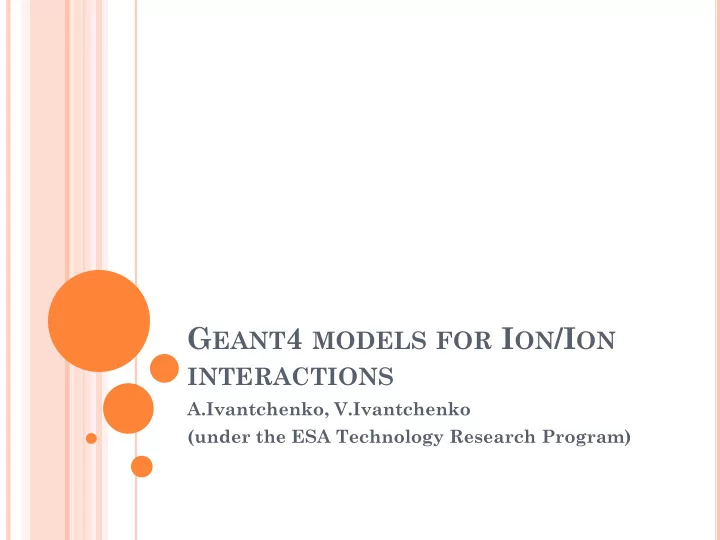

G EANT 4 MODELS FOR I ON /I ON INTERACTIONS A.Ivantchenko, V.Ivantchenko (under the ESA Technology Research Program)
S PACE APPLICATIONS OF G EANT 4 I ON /I ON MODELS (ESA PROJECT A06041) Ions flux on the Earth orbit Proton component of Cosmic Rays dominates Geant4 simulation for proton incident is reasonable Radiation damage provided by ions is significant Simulation precision for Geant4 Ion/Ion interactions is lower than that for protons Validation of ion/ion interactions is limited This work is also useful for other applications: LHC experiments NA61 (requested for DPMJET interface) 2 Hadron therapy communities
M ODELS AND P HYSICS L ISTS FOR I ON /I ON INTERACTIONS Models Physics Lists QBBC and QGSP_BIC BIC_ion Shielding QMD CHIPS CHIPS QGSP_INCL_ABLA INCL DPMJET-II.5 on top of any Abrasion Physics List FTFP_BERT in the future 3
G EANT 4 I ON /I ON CROSS SECTIONS C12 on Hydrogen, Carbon, and Aluminum QGSP_BIC Shielding QBBC Shape is not smooth Steps between Tripathi and Shen models 4 Axen-Wellish, Tripathi, and Shen for Hydrogen
DPMJET-II.5 INTERFACE High energies (E/A > 10 GeV/u) Ion/Ion interactions Software was provided by P. Truscott – it is a version prepared in MARS-REM project sponsored by ESA few years ago on base of the original DPMJET-II.5 FLUKA code Our experience with DPMJET interface Initially installation at SLC4 32 bit gcc3.4.6 was achieved Installation completely fails at SLC5 default compiler gcc4.1 Installation at SLC5 64 bit gcc4.3.2 and higher was achieved HADR02 extended example is created (g4 9.5beta) it can be used for all energies and any Physics lists thanks to Hisaya modification of G4VModularPhysicsList interface allowing substitute ion builder 5 Current version of the interface to DPMJET-II.5 is limited Z < 27
V ALIDATION RESULTS Test30 - thin target test, DDXS 6 Test45ion – Ion/Ion thick target test, NY HADR02 – high energy thick target test, fragments XS
QMD T HICK TARGETS NEUTRON YIELD : Statistic? C(H E 4, N ) 180 M E V/ U ( G 4.9.4) Steps in BICion 7
T HICK TARGET NEUTRON YIELD : A L (A R 40, N ) AT 400 M E V/ U (G4.9.4) Very typical - below 200 MeV models are wrong 8
S32 ON C ARBON AT 700 M E V/ U (9.4. REF 07) Z Good fragmentation cross section modeling for both QGSP_BIC and QMD 9
S32 ON C ARBON (15 MM ) AT 200 G E V/ U (9.4. REF 07) Z 10 DPMJET reproduces with some precision fragments cross sections
C ONCLUSIONS I ON /I ON MODELS BICion and QMD are stable and precise for energies 100 MeV/u - 10 GeV/u Problems below 50 MeV (Parallel session 4A) Nuclei's fragmentation (Parallel session 4A) DPMJET-II.5 model is precise for many targets at high energies, but has problems too FTF and CHIPS are expected to be an alternative for energies above 10 GeV/u 11
W HAT CAN BE DONE ? Continue validation of models. Regular runs of tests and availability on the web? Models improvements Problems in BICion QMD profile at low energies FTF, CHIPS and INCL are expected to be used Ion/Ion Inelastic Cross Section improvements Only one cross section database is available 12
Recommend
More recommend